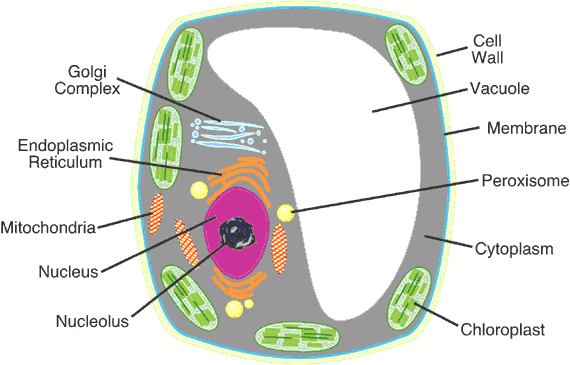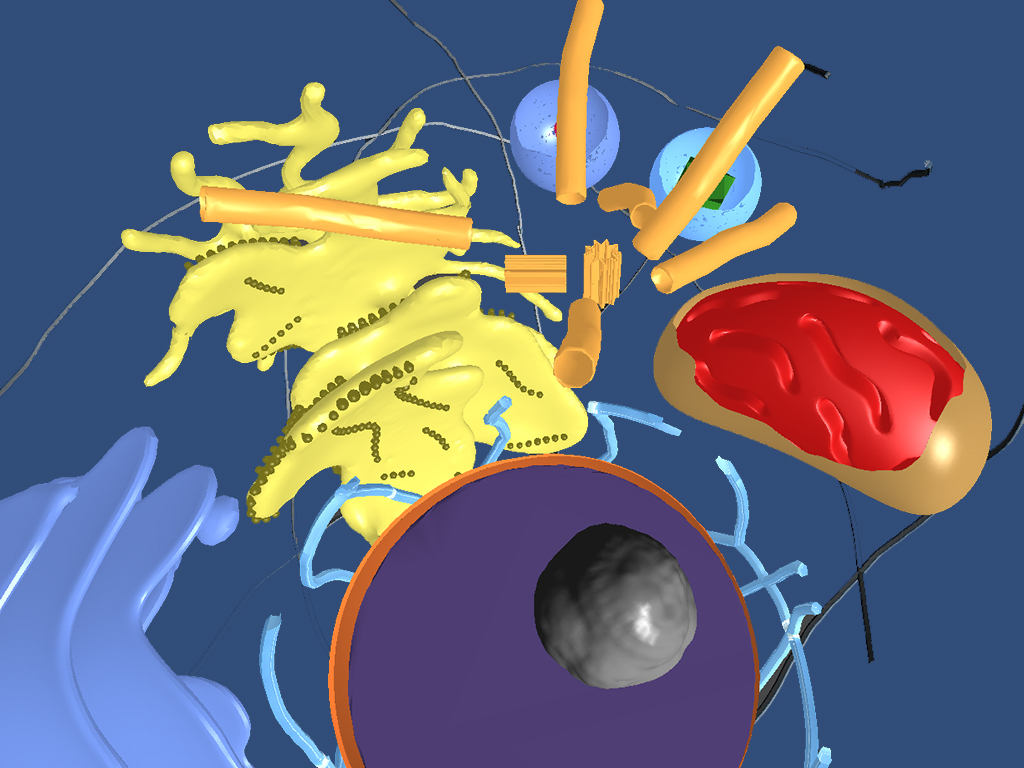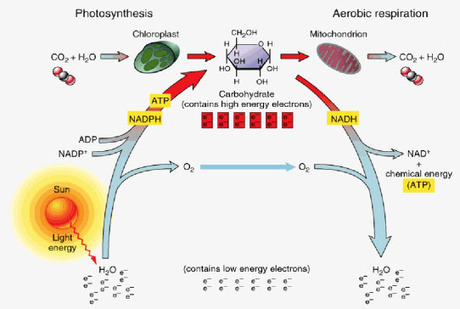Animal Cell Structure And Function Biography
Source:- Google.com.pk
The development of a fertilized egg into a newborn child requires an average of 41 rounds of mitosis (241 = 2.2 x 1012). During this period, the cells produced by mitosis enter different pathways of differentiation; some becoming blood cells, some muscle cells, and so on.
There are more than 100 visibly-distinguishable kinds of differentiated cells in the vertebrate animal. These are organized into tissues; the tissues into organs. Groups of organs make up the various systems — digestive, excretory, etc. — of the body.
The actual number of differentiated cell types is surely much larger than 100.
All lymphocytes, for example, look alike but actually represent a variety of different functional types, e.g., B cells, T cells of various subsets.
The neurons of the central nervous system must exist in a thousand or more different functional types, each representing the result of a particular pathway of differentiation.
This page will give a brief introduction to the major types of animal tissues. The links along the left side of the figure will take you directly to the individual paragraphs indicated.
Epithelial
Muscle
Connective
Nerve
Blood
1. Epithelial
Epithelial tissue is made of closely-packed cells arranged in flat sheets. Epithelia form the surface of the skin, line the various cavities and tubes of the body, and cover the internal organs.
Subsets of Epithelia
Epithelia that form the interface between the internal and external environments.
Skin as well as the lining of the mouth and nasal cavity. These are derived from ectoderm.
Inner lining of the GI tract, lungs, urinary bladder, exocrine glands, vagina and more. These are derived from endoderm.
The apical surface of these epithelial cells is exposed to the "external environment", the lumen of the organ or the air. [View example]
Mesothelia. These are derived from mesoderm.
pleura — the outer covering of the lungs and the inner lining of the thoracic (chest) cavity.
peritoneum — the outer covering of all the abdominal organs and the inner lining of the abdominal cavity.
pericardium — the outer lining of the heart.
Endothelia. The inner lining of the heart, all blood and lymphatic vessels — derived from mesoderm.
The basolateral surface of all epithelia is exposed to the internal environment (ECF). The entire sheet of epithelial cells is attached to a layer of extracellular matrix that is called the basement membrane or, better (because it is not a membrane in the biological sense), the basal lamina. [View example]
View showing relationship between the apical and basolateral surfaces of epithelial cells and how they maintain their distinction.
The function of epithelia always reflects the fact that they are boundaries between masses of cells and a cavity or space. Some examples:
The epithelium of the skin protects the underlying tissues from
mechanical damage
ultraviolet light
dehydration
invasion by bacteria
The columnar epithelium of the intestine
secretes digestive enzymes into the intestine;
absorbs the products of digestion from it.
An epithelium also lines our air passages and the alveoli of the lungs. It secretes mucus which keeps it from drying out and traps inhaled dust particles. Most of its cells have cilia on their apical surface that propel the mucus with its load of foreign matter back up to the throat.
2. Muscle
Three kinds of muscle are found in vertebrates:
Skeletal muscle is made of long fibers whose contraction provides the force of locomotion and other voluntary body movements.
Smooth muscle lines the walls of the hollow structures of the body, such as the intestine, urinary bladder, uterus, and blood vessels. Its contraction, which is involuntary, reduces the size of these hollow organs.
The heart is made of cardiac muscle.
Link to page devoted to the structure and properties of the three kinds of muscles.
3. Connective
The cells of connective tissue are embedded in a great amount of extracellular material. This matrix is secreted by the cells. It consists of protein fibers embedded in an amorphous mixture of protein-polysaccharide ("proteoglycan") molecules.
Supporting connective tissue
Gives strength, support, and protection to the soft parts of the body.
cartilage. Example: the outer ear
bone. The matrix of bone contains collagen fibers and mineral deposits. The most abundant mineral is calcium phosphate, although magnesium, carbonate, and fluoride ions are also present. [More on bone]
Dense connective tissue
Often called fibrous connective tissue.
Tendons connect muscle to bone. [View] The matrix is principally Type I collagen, and the fibers are all oriented parallel to each other. Tendons are strong but not elastic.
Ligaments attach one bone to another. They contain both collagen and also the protein elastin. Elastin permits ligaments to be stretched.
Loose connective tissue
It is distributed throughout the body. It serves as a packing and binding material for most of our organs. Sheets of loose connective tissue that bind muscles and other structures together are called fascia. Collagen, elastin, and other proteins are found in the matrix of loose connective tissue.
Both dense and loose connective tissue are derived from cells called fibroblasts [View], which secrete the extracellular matrix.
Adipose tissue
Adipose tissue is "fat". There are two kinds found in mammals:
white adipose tissue (WAT) in which the cells, called adipocytes, have become almost filled with oil. The oil is confined within a single membrane-enclosed droplet. Virtually all of the "fat" in adult humans is white adipose tissue.
brown adipose tissue (BAT) in which the adipocytes contain many small droplets of oil as well as many mitochondria.
White adipose tissue and brown adipose tissue differ in function as well as cellular structure. These differences are described on a separate page. Link to it.
New adipocytes in white adipose tissue are formed throughout life from a pool of precursor cells. These are needed to replace those that die (after an average life span of 10 years). Whether the total number of these adipocytes increases in humans becoming fatter as adults is still uncertain. If not, why do so many of us get fatter as we age? Because of the increased size of individual adipocytes as they become filled with oil.
The adipocytes of white adipose tissue secrete several hormones, including leptin and adiponectin.
4. Nerve
Nerve tissue is composed of
nerve cells called neurons and
glial cells.
Neurons
Neurons are specialized for the conduction of nerve impulses. A typical neuron consists of
a cell body which contains the nucleus;
a number of short fibers — dendrites — extending from the cell body
a single long fiber, the axon.
The nerve impulse is conducted along the axon.
Link to a page devoted to neuron structure.
The tips of axons meet:
other neurons at junctions called synapses
Link to a page describing the properties of synapses.
muscles (called neuromuscular junctions)
Link here to a page describing the neuromuscular junction.
glands
Link here to a page describing how neurons work.
Link here to a page describing the types and organization of neurons in the peripheral nervous system.
Glia
Glial cells surround neurons. Once thought to be simply support for neurons (glia = glue), they turn out to serve several important functions.
There are three types:
Schwann cells. These produce the myelin sheath that surrounds many axons in the peripheral nervous system.
Oligodendrocytes. These produce the myelin sheath that surrounds many axons in the central nervous system (brain and spinal cord).
Astrocytes. These — often star-shaped — cells are clustered around synapses and the nodes of Ranvier where they perform a variety of functions:
modulating the activity of neurons [An example] [Another example];
supplying neurons with materials (e.g. glucose and lactate) as well as some signaling molecules;
regulating the flow of blood to their region of the brain. It is primarily the metabolic activity of astrocytes that is being measured in brain imaging by positron-emission tomography (PET) and functional magnetic resonance imaging (fMRI).
pruning away (by phagocytosis) weak synapses.
In addition, the central nervous system contains many microglia — mobile cells (macrophages) that respond to damage (e.g., from an infection) by
engulfing cell debris
secreting inflammatory cytokines like tumor necrosis factor (TNF-α) and interleukin-1 (IL-1)
Microglia are also active in the healthy brain, at least in young mice where, like astrocytes, they engulf synapses thus reducing the number of synapses in the developing brain.
Animal Cell Structure And Function Animal Cell Model Diagram Project Parts Structure Labeled Coloring and Plant Cell Organelles Cake


Animal Cell Structure And Function Animal Cell Model Diagram Project Parts Structure Labeled Coloring and Plant Cell Organelles Cake


Animal Cell Structure And Function Animal Cell Model Diagram Project Parts Structure Labeled Coloring and Plant Cell Organelles Cake


Animal Cell Structure And Function Animal Cell Model Diagram Project Parts Structure Labeled Coloring and Plant Cell Organelles Cake


Animal Cell Structure And Function Animal Cell Model Diagram Project Parts Structure Labeled Coloring and Plant Cell Organelles Cake


Animal Cell Structure And Function Animal Cell Model Diagram Project Parts Structure Labeled Coloring and Plant Cell Organelles Cake


Animal Cell Structure And Function Animal Cell Model Diagram Project Parts Structure Labeled Coloring and Plant Cell Organelles Cake


Animal Cell Structure And Function Animal Cell Model Diagram Project Parts Structure Labeled Coloring and Plant Cell Organelles Cake


Animal Cell Structure And Function Animal Cell Model Diagram Project Parts Structure Labeled Coloring and Plant Cell Organelles Cake

Animal Cell Structure And Function Animal Cell Model Diagram Project Parts Structure Labeled Coloring and Plant Cell Organelles Cake


Animal Cell Structure And Function Animal Cell Model Diagram Project Parts Structure Labeled Coloring and Plant Cell Organelles Cake
No comments:
Post a Comment